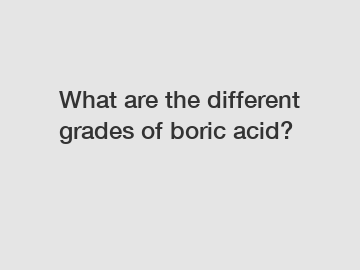What are the different grades of boric acid?
What are the different grades of boric acid?
Boric acid is a versatile compound that finds its use in various industries, from pharmaceuticals to cosmetics, and even as an insecticide. It is a white crystalline solid, commonly available as a powder, and is known for its antiseptic, antifungal, and flame-retardant properties. It's important to know that boric acid comes in different grades, each suited for specific applications. So, let's delve into the different grades of boric acid and their uses.
1. Technical Grade Boric Acid:

Technical grade boric acid is the most common form and is widely used in industries. It is relatively less pure compared to other grades and typically contains around 85-99% boric acid. This grade is suitable for applications like manufacturing fiberglass, ceramics, and fertilizers. It also serves as a raw material for other boric acid derivatives, such as borates for detergent production.
2. Pharmaceutical Grade Boric Acid:
Pharmaceutical grade boric acid is produced with higher purity levels to meet the stringent requirements of the pharmaceutical industry. It must adhere to specific standards and regulations to ensure its safety and suitability for medicinal purposes. This grade is commonly used in eye drops, ointments, and oral capsules for its antiseptic and antibacterial properties. It's crucial to note that pharmaceutical grade boric acid should never be ingested without proper medical guidance.
3. Food Grade Boric Acid:
Food grade boric acid, as the name suggests, is suitable for use in the food industry. It is highly purified and meets all the safety standards imposed by regulatory authorities. Food grade boric acid is primarily used as a preservative for certain food products, such as caviar and margarines, to prevent spoilage. However, it is essential to point out that the use of boric acid as a food additive is regulated, and maximum permitted levels need to be strictly followed to ensure consumer safety.
4. Reagent Grade Boric Acid:
Reagent grade boric acid is known for its extremely high purity, usually exceeding 99.5%. It is commonly used in laboratories for analytical testing, research, and development purposes. Reagent grade boric acid is free from impurities that might interfere with experimental results. Scientists and chemists rely on this grade to obtain accurate and reliable data in various scientific studies.
5. Cosmetic Grade Boric Acid:
Cosmetic grade boric acid is specially formulated and purified to meet the requirements of the cosmetic industry. It is commonly used in skincare products, such as lotions, creams, and cosmetics, due to its mild antiseptic and antifungal properties. Cosmetic grade boric acid helps to regulate the pH balance of the skin and prevent bacterial growth, making it an essential ingredient in many personal care products.
In conclusion, boric acid is available in various grades, each tailored to specific applications. Technical grade boric acid finds its use in industries like ceramics and fertilizer production. Pharmaceutical grade boric acid is strictly regulated and utilized in medicinal preparations. Food grade boric acid serves as a preservative for certain foods, while reagent grade boric acid is used in laboratories for analytical purposes. Lastly, cosmetic grade boric acid is popular in skincare products for its mild antiseptic properties. Depending on your intended use, selecting the appropriate grade of boric acid ensures optimal results and safety.
Want more information on cas 109555 87 5, cas 109555 87 5, cas 109555 87 5? Feel free to contact us.

Comments
0